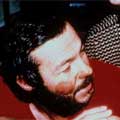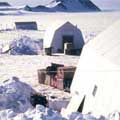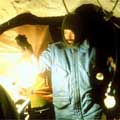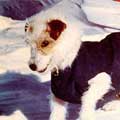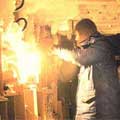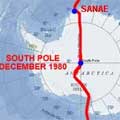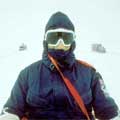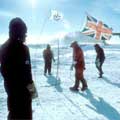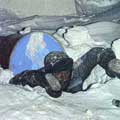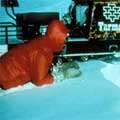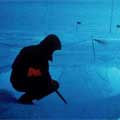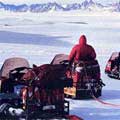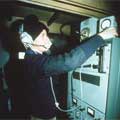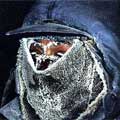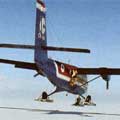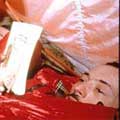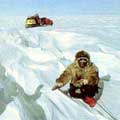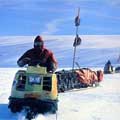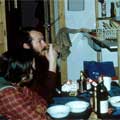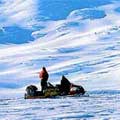Part 2: The Antarctic
January 1980 – April 1981
Overwintering (by Ran Fiennes)
There are five of us here, but the different scientific jobs take place in three different huts by day and night, so we see very little of each other except at breakfast and supper, the two meals of the day.
Ginny, my wife, is the radio operator in charge of the VLF Whistler Programme. Hour after hour, in the 10-ft hut under the snow and half-a-mile away from the other huts, she monitors strange ethereal signals coming from Newfoundland via the magnetosphere. The results of her work will be analysed at Sheffield University.
To reach the VLF hut in the pitch black and the driven snow she gropes along safety lines knowing that to miss the line could result in quick disorientation and fairly quick death. As I write, the wind chill factor is -116° F (-82 °C) in which exposed flesh freezes in under 25 seconds. The visibility is two yards. Ginny’s previous job consisted of secretarial work in Sussex and being a warden/guide with the National Trust of Scotland in West Kinloss.
The polar credentials of the others are equally unimpressive. Charlie Burton, cook and electrician, was a London Securicor executive. Now he spends his days trying to trace splits in electric cable caused by the cold and movement of ice, and in thawing out blocks of cheese or food tins to prepare for the evening meal. Charlie is engaged and will be married in Sydney next year.
Oliver Shepard, whose wife is in London, is the mechanic and meteorologist. He often sleeps when the others are awake, and vice versa, for he has to check his weird beehive and other monitors every six hours each day with radio reports to the world meteorological organisation. He put his sunshine recorder away early in May when the sun disappeared not to be seen again for many a long day. Oliver slaves away in another hut servicing the Allam generators which turn out all our electricity. Before joining the expedition he was Bass Charrington’s man in East London.
The fifth character is Bothy, Ginny’s long-haired Jack Russell terrier, a friend and welcome distraction to everyone. He’s never had it so good. Back in Hammersmith he was alone, save for the neighbour’s cats, from 7.00 a.m. to 8.00 p.m. every weekday. Now he is played with hour after hour and given frozen chocbar supplements to his regulation Chum. He, for one, is never lonely – though what will happen next March in Auckland when he meets up with a female of his own kind is anybody’s guess.
Our isolation is complete. The nearest people are 206 miles away to the north across two ranges of mountains each surrounded by a snowfield and a great crevasse barrier. Over twice that distance across another stretch of freak mountains is a Russian space station where not long ago the charred remains of the occupants were found in their burnt-out shack. Fire is a hazard always on the mind.
Our huts are made completely of thin cardboard with a single layer of insulation, bolted to light wood floor boards sitting on the ice. Each violent blow as the katabatic polar winds strike the roofs — the rest of the huts are snowed under — shakes the fragile cardboard jointing, noisily emphasising the power of the elements and our own insignificance.
One could say we were the most cut-off people in the world with some justification. But not the most lonely. Charlie says, “I like solitude.” Then he adds with a grunt, “for a short time.” I don’t believe him as he is the gregarious sort, never happier than in a crowded pub, his distinctive laugh audible above all the din. He muses that he feels his loneliest when on the squeeze box.
Our loo is a large tin, set in an alcove, down one of the long ice tunnels adjacent to the living hut. The tunnels are lined with stores of every description from generator spares to parachutes and are constantly at a temperature of -27°C whatever the outside temperature.
The Crossing (by Ran Fiennes)
Charlie and Ollie wear five layers of clothing, topped by Eskimo wolf-skin parkas. I too have five under-layers, but my outer one consists of a large duvet jacket of duck down; perhaps not quite as warm as theirs but much easier to move about in and see out of. Despite three-layer footwear, mitts, caps, goggles and face-masks, the cold cuts through as though we were naked.
The thirtieth of October is unpleasant. A thirty-knot wind stirs the snow and soon sets up pea-souper conditions. We climb gradually: the true plateau is still 4000 feet above us. Hard ice bumps, not visible in the gloom, upset our skidoos. As they roll over, the riders must jump well clear to ensure their legs are not crushed between the ice and the machines.
When we packed up our three-man tent Ollie told me he felt very tired. This was unusual from someone who never complains about his sufferings. After four hours’ travel he staggered off his skidoo and lurched over un-roped. His speech was slurred. “I’m getting exposure. Must stop a bit.” He was shivering. As medic he knew exactly what symptoms to expect. In these conditions it would take us two hours to make camp so Charlie and I merely unpacked the vehicle tarpaulin and, struggling against the wind, secured it around a sledge in such a way as to provide a small windproof shelter. We boiled water from snow and gave Ollie two mugs of tea and some chocolate. He is physically the toughest of us all, so if he is already shivering on day two, despite full polar gear and a wolf-skin, then we will have to be very careful indeed.
December… now the polar summer was with us and life was positively comfortable in terms of temperature for we were well into the -30°+ F (-20°C). But the sastrugi did not improve. Day by day they increased in size and number. The sastrugi ridges resembled a ploughed field with the ridges running directly across our line of advance. For 200 miles these ridges averaged two to three feet high.
With breaks of 0.5 to 1.5 miles (1-2 kms) between them, these forbidding sastrugi fields carried on for 300 miles (480 kms), sometimes almost impassable, sometimes mere serried waves of ice bric-a-brac. With increasing frequency whiteout conditions clamped down. To negotiate even the lesser sastrugi belts without a clear idea of where the bumps were would be asking for trouble so we always stopped until the light improved.
At 0435 hours on 15 December 1980, we finally arrived at the bottom of the earth. The American scientists at the cosy South Pole station were friendly and hospitable. We camped, 100 yards from the metal dome that houses their work-huts but, in exchange for washing up dishes and cleaning the canteen, we ate with them. We also found time to beat the Americans at the first ever game of cricket to be played at the South Pole.
With our base group all at the Pole I wanted to press on. The second half of our journey involved some 180 miles (290 km) to the edge of the high plateau, a 146-mile descent down a mountain-girt valley – the Scott Glacier, and 600 miles over the Ross Ice Shelf to the sea at McMurdo Sound.
Early on 28th December, in a whiteout with wind gusting to forty knots, we skirted the east side of Garner Ridge, and followed the Klein Glacier for a dozen miles (19 km) to the mist-blurred outline of the Davis Hills. Here the Scott and Klein Glaciers clash with a silent but ferocious force, creating a jumble of gleaming chaos for some miles.
The crevasse field ended in a mile or so. Then gradually our route veered north-north-east and the Scott Glacier fell away before us to reveal a breathtaking panorama of mountain and glacier, ice field and sky. The world seemed to start at our feet, dropping 2000 feet (1600 metres) to the far horizon where our highway disappeared between the cliffs of Mount Walshe and the Organ Pipe Peaks. Keeping to the centre of the glacier we made good time for thirty miles until a rash of rotten snow-bridges collapsed beneath us. Everyone suffered shocks. As usual Ollie at the back was worst off.
We veered to the western flank of the glacier but Charlie’s sledge collapsed a wide snow bridge. I saw Ollie struggling to help extricate the dangling load but was not going back over one step of the perilous route unless needed, so I sat and watched until they were again en route. We climbed over 1000 feet to a high wild pass where the wind bit through our clothes and whipped up spirals of snow from the granite fortress of Mount Ruth and its senior twin Mount Gardiner. To the west we could see a ragged company of primordial peaks spearing the sky, mere reminders of the vastness of their ice-buried bulk. Around them curled serpentine rivers of ice bearing names from the “heroic age” of polar exploration; the Amundsen, Axel Heiberg and Devil’s Glaciers.
From the pass we climbed still higher to the north until at the extremity of the detour, we arrived at the crown of a steep valley leading back down to the Scott Glacier. Charlie, careful never to sound excited about anything, described the subsequent downhill journey:
“The descent was a nightmare which I don’t care to recall. Some people will think it must have been easy, simply because we descended so quickly. All I can say is let them try. Ran and Ol were as frightened as I was, even if they don’t admit it. That’s why Ran kept going hour after hour without stopping. He zigzagged in every direction trying to avoid the worst areas. He didn’t have much success and on one of the upper ledges we found reared above us as we slithered along a maze of cracked corridors, totally trapped. My sledge took an eight-foot wide fissure diagonally and broke through the bridge. My skidoo’s rubber tracks clawed at the blue ice, slipped sideways and the sledge began to disappear. I was lucky. A patch of grainy white ice gave the tracks just enough forward purchase to heave forward again. The sledge wallowed up and over the forward lip of the crevasse.
“I could mention a hundred or more such incidents during the descent. Each of us could – but what’s the point? Nobody who wasn’t there, who hasn’t felt the deadly lurch of snow giving way under his seat, hasn’t seen the line upon line of white or blue telltale shadows in a major crevasse field and been forced to carry on going over more and more, for hour after hour, can imagine the sweaty apprehension we experienced.”
On the fifth day out from the glacier’s snout, we completed seventy-nine nautical miles (146 km) in ten hours. The glare was intense and I navigated by storm clouds to the west. On the seventh day we crossed the 180° meridian which, at this point, is also the International Date Line. We increased our mileage for the day to ninety-one nautical miles (168 km) and used only a gallon for each eight miles. On the ninth day despite a semi-whiteout we drove one hundred nautical miles and likewise on the tenth when, at noon a white mushroom cloud first became visible on the horizon ahead and to the right: the steam cloud of Mount Erebus. Beneath this 13,000 foot volcano nestled our goal, Scott Base.
On 10th January after eighty-one nautical miles and some unpleasant crevasses, we camped at the tip of White Island. Two hours out from Scott Base, Charlie’s skidoo developed piston trouble. Ollie had carried a spare engine all the way from Ryvingen, now he put it to good use.
Next day at six p.m. Roger Clark, the New Zealand Commander of Scott Base, came out to meet us with a sledge drawn by huskies. He led us over the sea-ice, scattering docile seals and screaming skuas, to Pram Point where the wooden huts of his base huddle by the edge of the sea. Above on the rocks some sixty New Zealanders looked down as a kilted piper struck up the haunting tune, “Amazing Grace”.
In 67 days we had crossed Antarctica but the circumpolar journey was not yet half complete.

